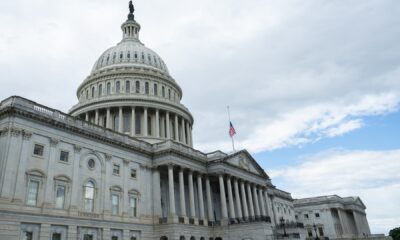Voters stand in line at a local polling station in Washington, DC, on November 5, 2024. Americans cast their ballots in the presidential race between Republican nominee former President Donald Trump and Democratic nominee Vice President Kamala Harris, as well as multiple state elections that determine the balance of power in Congress. (Photo by Nicolas Economou/NurPhoto via Getty Images)
Nicolas Economou | Nurphoto | Getty Images
Going into election day, Americans were sharply divided. But the gender gap was among the most glaring splits, with more women backing Vice President Kamala Harris and a majority of men supporting President-elect Donald Trump.
Women favored Harris by an 8-point margin, with the vice president securing 53% support compared to Trump’s 45%. Men backed Trump by a 13-point margin, with 55% favoring Trump and 42% backing Harris — resulting in a 21-point gender divide, according to NBC News exit polls.
Trump gained massive support among men on economic issues, specifically, including Hispanic and Black voters who were feeling particularly pessimistic. Inflation was the top concern among voters overall, followed by the current state of the economy.
More from Personal Finance:
How Trump’s win could change your health care
Credit card debt hits record $1.17 trillion, New York Fed research shows
Here’s what the Trump presidency could mean for the housing market
A factor that drove young men to the polls may have been perceived economic disparities, according to experts, which ultimately helped Trump win on Election Day.
“Men feel like there’s no pathway for economic mobility for them,” said Julia Pollak, chief economist at ZipRecruiter.
‘That is a huge, huge gap’
There is a growing disillusionment taking hold.
Men are steadily dropping out of the workforce, especially those between the ages 25 to 54, which are considered their prime working years.
A study by the Pew Research Center found that men who are not college-educated leave the workforce at higher rates than men who are. At the same time, fewer younger men have been enrolling in college over the past decade.
In 1995, both young men and women equally were likely to hold a bachelor’s degree, at 25%. Today, 47% of women of ages 25 to 34 in the U.S. have a bachelor’s degree, compared with 37% of men their age, also according to Pew.
“That is a huge, huge gap,” Pollak said.
Schools often tout a four-year degree as the ideal scenario. And in many areas, vocational programs and other alternative pathways “aren’t as widespread” as they used to be, Pollak said.
At the same time, some traditional blue-collar jobs that used to employ more non-college educated men declined due to automation and globalization, leading to job displacement and uncertainty about future employment prospects, experts say.
Altogether, you have a group who feel like they’re “being left behind,” Pollak said.
Brett House, an economics professor at Columbia Business School, agreed: “The great concern is that we are developing a pool of young men that are neither developing the additional skills [nor] education necessary to participate fully in the labor force,” he said — particularly in “former manufacturing industrial powerhouse states.”
These days, young men are more likely to be considered NEETs — neither in employment, education or in training — a cohort that has been hardest hit by globalization and the decline of manufacturing in this country, according to Richard Fry, a senior researcher at Pew.
“When you don’t get rewarded for working, you work less,” Fry recently told CNBC. “That is a basic tenet of labor economics.”
Men were more likely than women to say they believed the results of the election would impact their financial life in the short term, according to a separate survey by NEFE. Those voters largely favored Trump.
Those with less than a high school diploma and those with a two-year degree were also most likely to say their financial life will be impacted by the presidential election. NEFE polled 1,000 adults about their financial feelings in relation to the 2024 general election in October.
“It’s reasonable that many Americans were weighing their current financial well-being and prospects for the future while casting their votes this November,” said Billy Hensley, NEFE’s president and CEO. Hensley is also a member of the CNBC Global Financial Wellness Advisory Board.
Young women have ‘made huge gains’ in the workforce
Meanwhile, women have “made huge gains” in their education and careers and working as much, if not more, than their male counterparts, according to Ali Bustamante, an economist and director at the Roosevelt Institute.
Today, women are getting married and having children later, if at all, and are prioritizing their careers, Pollak said. They’re looking to the government to make that choice less difficult through universal child care and access to abortion, she said.
“There was a time when people were either mothers and wives, or spinsters who worked,” Pollak said. “Now women often are prioritizing the career person over the wife and mother.”
However, while the issue of reproductive rights became a major factor in the 2024 presidential race, it did not drive more women to vote. It also did not prove to be one of the most important issues facing the country among voters overall, exit polls showed.
“Trump’s message resonated with young men,” said Fatima Goss Graves, president of the National Women’s Law Center Action Fund. “The pain that people in this country has been feeling in terms of the economy is real.”
Still, other issues — such as paid leave, affordable housing, child care and equal pay — are also hugely important to families, she said.
“This was one election, but I think it would be a mistake to suggest that women will stop fighting in larger numbers either for reproductive freedom or the things they care about — we have work to do,” Graves said.
Subscribe to CNBC on YouTube.


 Blog Post1 week ago
Blog Post1 week ago
 Economics1 week ago
Economics1 week ago
 Finance1 week ago
Finance1 week ago
 Personal Finance1 week ago
Personal Finance1 week ago
 Accounting1 week ago
Accounting1 week ago
 Economics1 week ago
Economics1 week ago
 Personal Finance7 days ago
Personal Finance7 days ago
 Personal Finance1 week ago
Personal Finance1 week ago











